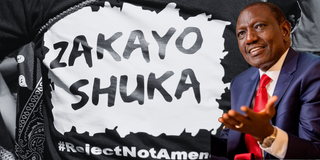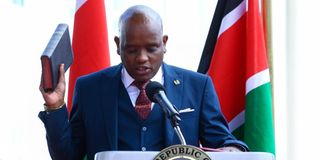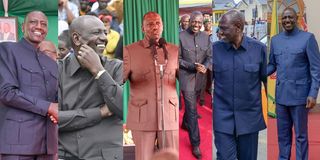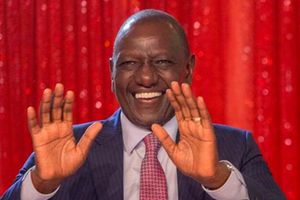
The mass protests against the Ruto regime are an expression of Kenyans’ frustration and dissatisfaction with the performance of their government.
It started as a series of viral videos depicting warthogs acting funny in the wild, with the voiceover of a man singing the 1977 Orch Super Mazembe song “Kasongo”.
Thanks to the voiceover, the warthog acquired the name “Kasongo” from social media users. Then, out of nowhere, the nickname started being used on President William Ruto.
That was in late 2024.
Around the same time, silhouette cartoons depicting Dr Ruto in various situations became a currency on social media.
With a nickname and a laughable cartoon character, social media users were on a roll as the President was lampooned left, right and centre. The name “Kasongo” thus stuck on Dr Ruto like a tick to a cow.
Ruto's counter

Dennis Itumbi takes oath of office as a CAS on March 23, 2023.
However, in a classic Dr Ruto move, a counter-narrative was quickly created. His communication “fighters” led by Dennis Itumbi, now the Head of Presidential Special Projects and Creative Economy Coordination, quickly responded with less derogatory silhouettes as they pushed the clarion call “Ruto Delivers”.
Though the main creator of the silhouettes went mum and slowed down in making them after his release, the response was a sample of how Dr Ruto’s presidency has been in terms of the brand it seeks to project.
Ever since he won the mandate as Kenya’s fifth president, he has gathered a generous serving of monikers. But whenever a new nickname emerges, he has been known to quickly own it or craftily counter it, sometimes taking the sting off it.
“Si mtanimaliza na majina (Won’t you finish me with [nick]names)?” he asked at a rally in Nairobi in March.
He added that at the beginning, he was simply William Kipchirchir Samoei Ruto.
“You added ‘Hustler’. Then you added ‘Survivor’. Then you added ‘Zakayo’. Now you are at ‘Kasongo’. With all these names, do you still have another, or is it enough?” he asked.
Kenyans still had more names to give him.
Since then, he has collected “Wantam” (a word play on “one term” that his critics are using to rally against re-electing him in 2027).
And, as sure as night follows day, the President’s communication team fought back, wanting Dr Ruto to be known as Wan Mo Tam (“one more term”) even as they used the opportunity to remind the country of Dr Ruto’s achievements in his two years in power.
The nicknames sometimes come with his attributes or utterances.
“Zakayo” was in response to the aggressive tax measures he wanted to introduce before youth-led protests in mid-2024 slowed him down.
“El Chapo” emerged because he had promised to buy a machine that makes a million chapatis to feed Nairobi’s primary school children.
“Must Go” was drawn from the rallying calls of the 2024 protests—and “Ruto must go” has become a slogan chanted at many social gatherings since then. “Nabii” arose from the image he projected of a friend of the church who was once a preacher.
His response to some of the nicknames appears to be inspired by the Swahili saying “mkono usioweza kuukata ubusu (embrace the hand you can’t cut)”.
For instance, he left many confused when he danced to the “Kasongo” song during New Year’s Eve at the Kisii State Lodge, at a time when it could have been considered an insult to even play it. He has danced to the song on numerous occasions in public ever since.
On the Zakayo nickname, he once argued that it is not that bad because the Biblical man it refers to (Zacchaeus, the tax collector) got to meet Jesus.
“It is not bad to collect taxes to take Kenya forward,” he said. “If you don’t become [Zaccheus], how can God visit you?”
At the March rally, he said: “I don’t worry about names, provided we do our work to push Kenya forward.”
That message was echoed by Wanjohi Githae, a State House public communications director.
“President Ruto is a man determined to take Kenya to its rightful place. For so long, Kenya has been held back by visionless and clueless leadership. The President is busy making the right and bold decisions for Kenya, however unpopular they may be in the interim,” Mr Githae told Nation.
“He is a man on a mission with no luxury to be side-stepped by nicknames. Nicknames or no nicknames, affordable housing is up and running, TaifaCare is revolutionising the provision of healthcare while fresh produce markets are already beginning to dignify Mama Mboga and traders in our country,” he added.
Some analysts see the accumulation of nicknames as a way of coping with tough economic times caused by Dr Ruto’s policies.
Meanings behind names
Dr Kenneth Ombongi, a senior lecturer at the Department of History and Archaeology at the University of Nairobi, says Dr Ruto’s many promises when he was campaigning for the presidency have not been fulfilled. So, a frustrated populace is seeking coping mechanisms.
“Nicknames for leaders are not new. They are as old as leadership itself. Throughout history, prominent figures have attracted monikers that either endeared them to the public or, in some cases, highlighted their perceived flaws.
“In many African countries, early post-independence leaders were given honorific or affectionate titles that captured the public’s admiration.
For example: Mzee (old man) for Jomo Kenyatta, Ngwazi (lion) for Kamuzu Banda of Malawi, KK (initials of names) for Kenneth Kaunda, Mwalimu (teacher) for Julius Nyerere, Osagyefo (lion) for Kwame Nkrumah, and Tata Madiba (father) for Nelson Mandela.
These names reflected respect, reverence, and a certain fatherly symbolism in the national imagination,” said Dr Ombongi.
“In contrast, the proliferation of nicknames for President Ruto seems to take a different trajectory, many are mocking or critical. This is telling. The President rode to power on a compelling and emotionally charged campaign that invoked divine purpose and upliftment.
However, for many citizens, the delivery of that promise has felt markedly different. What was cast as a heavenly mission has been experienced by some as a difficult and even punishing reality.
This disconnect has become fertile ground for satire and ridicule, especially in a society like Kenya’s — politically vibrant, expressive, and economically burdened,” he added.
In Dr Ombongi’s view, the contrast between the “praise” nicknames for Africa’s post-colonial leaders and the “mocking” nicknames for Dr Ruto shows the “frustration, disappointment, or scepticism” among Kenyans. It is “a stark reflection of the public mood”.
Kaunda suits

On Wednesday, he snubbed the almost obligatory suit for someone holding an office like his in favour of a Kaunda suit when he received US chief trade adviser and spokesperson on trade policy Katherine Tai. He also wore one when he travelled to Kericho to launch a water supply project in Ainamoi.
Another hallmark of Dr Ruto’s presidency has been his Kaunda suits. From mid-2023, he has proved to be a fan of the safari suit, originating from overseas but popularised in Africa by Zambia’s founding president, Kenneth Kaunda.
In an interview with Nation in November 2024, menswear entrepreneur Ashok Sunny – who used to be Dr Ruto’s tailor when he was Deputy President – said it is probable that the President orders the Kaunda suits off-the-rack (in a standard size) rather than have them tailor-made.
“We used to make his suits when he was a DP. We have not made suits for him since he became President. I think it’s because of the Kaunda suits; he’s been doing them more,” said Mr Sunny, the CEO of Ashok Sunny Tailored.
Predictably, the Kaunda suit contributed to one of Dr Ruto’s many nicknames.






